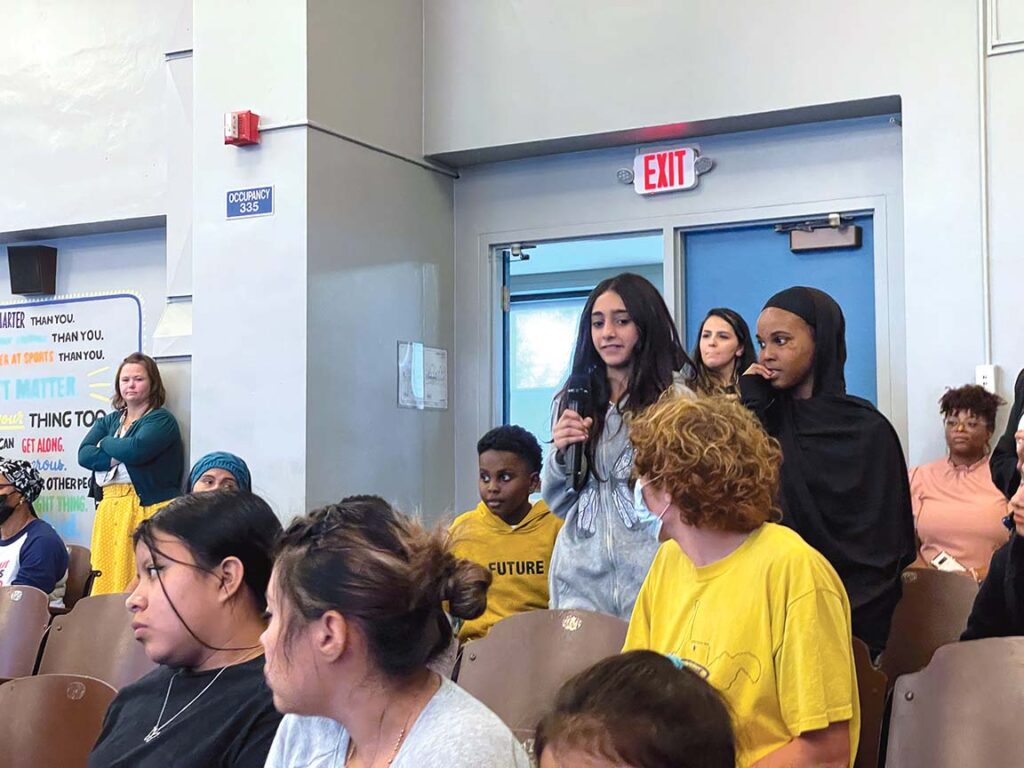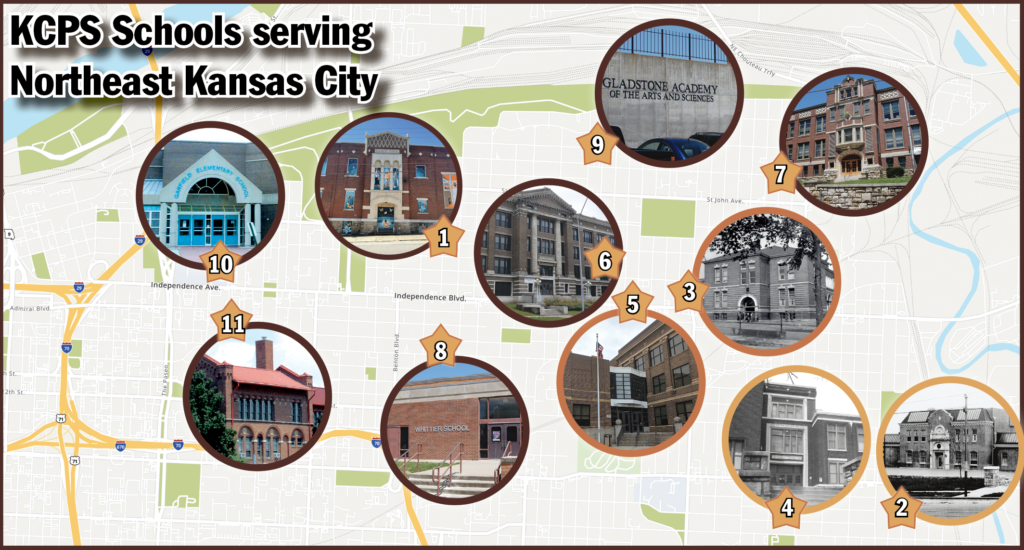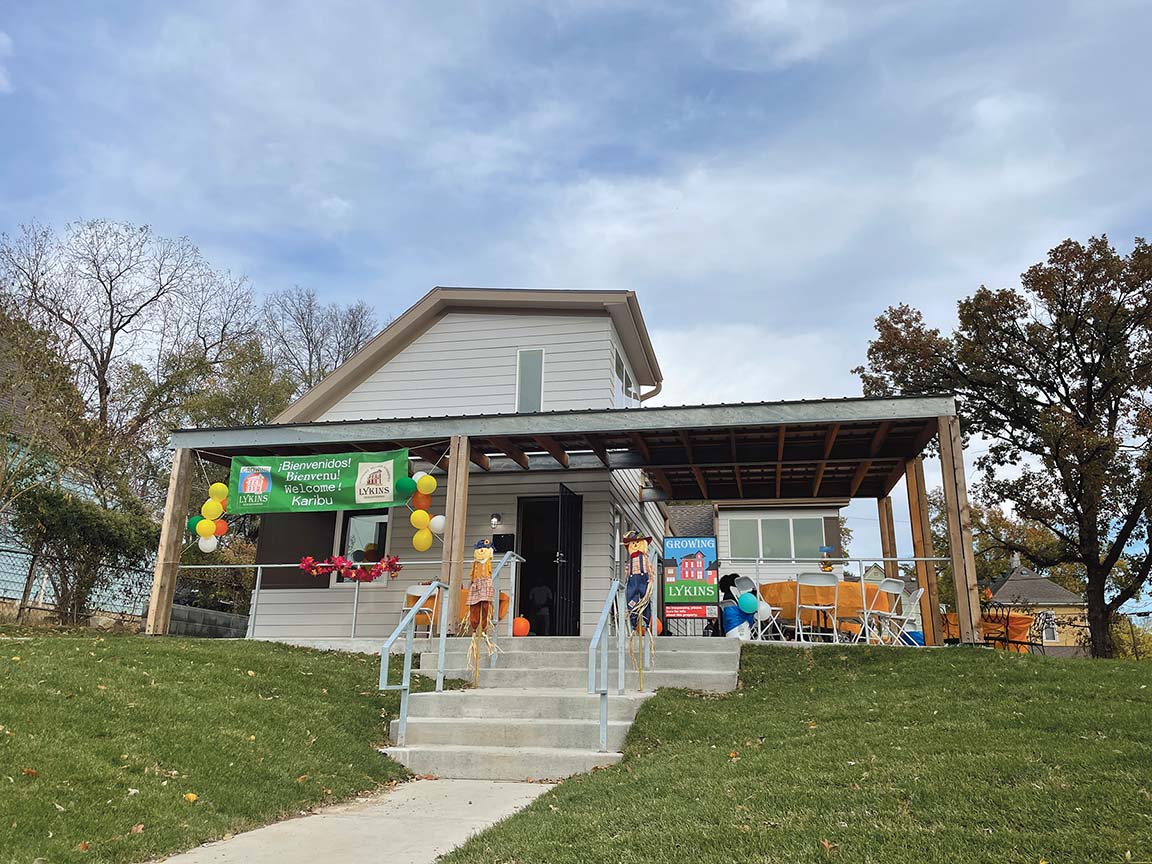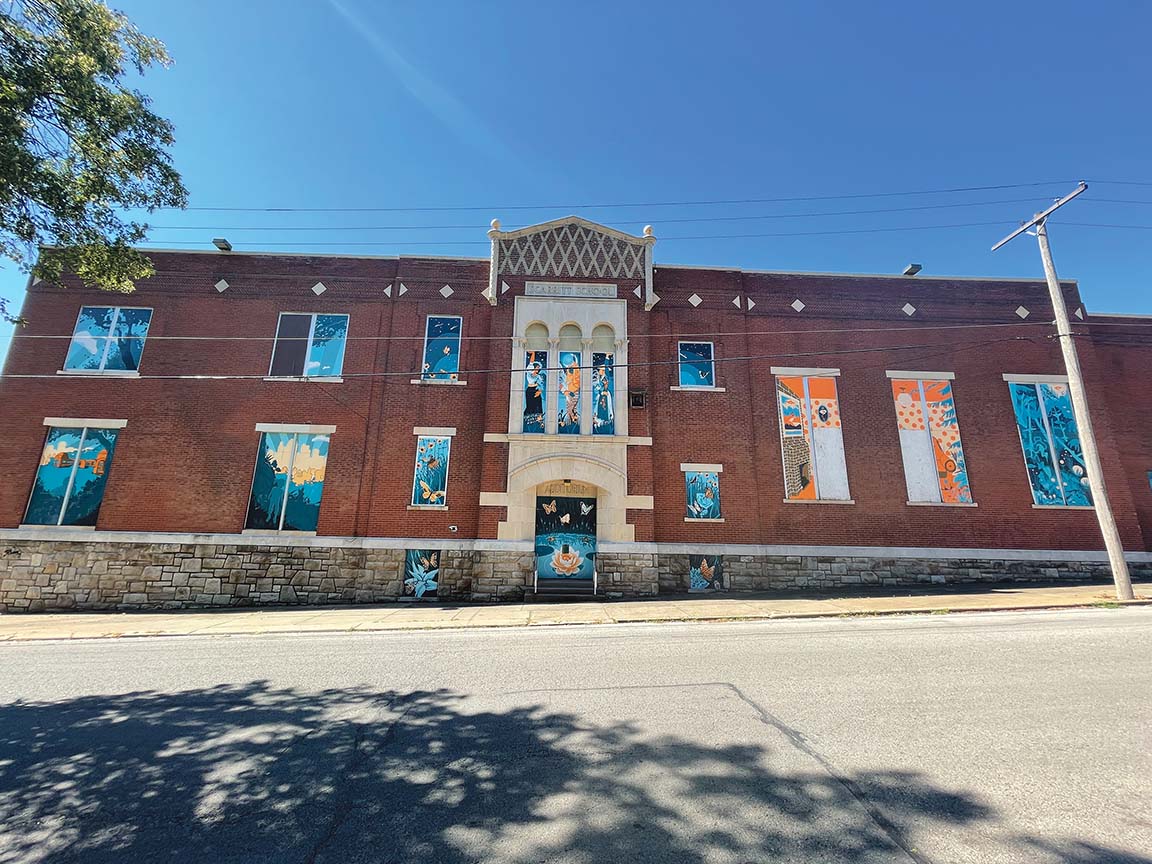
Abby Hoover
Managing Editor
Kansas City Public Schools (KCPS) recently hosted Community Chats in its Blueprint 2030 plan. Based on recommendations by MGT Consulting Group, KCPS could close as many as 10 schools, including three in Historic Northeast Kansas City.
The schools the district is considering to close or convert to another use include Northeast High School on Van Brunt in Indian Mound, James Elementary in the northeast corner of Indian Mound, and Whittier Elementary in Lykins. For more information on the plan, read the Northeast News’ previous reporting at northeastnews.net/pages/kcps-considers-closing-10-schools-3-in-northeast/.
NORTHEAST MIDDLE
At the Northeast Middle School Community Chat on October 25, Northeast High School alumni showed up in force to oppose the closing of their school. The strong alumni association supports scholarships for Northeast students, a food pantry and a clothes closet.
The District presented a summary of the recommendations before dividing the audience into breakout groups where they discussed what they were excited about in the plan, what they were concerned about, and other questions they had, prior to sharing with the larger group.
Bryce Abbott, senior at NEHS and student council representative, showed up to the meeting to protect his school, especially the history and pride the students have in the longtime institution.
“Northeast is on the rise right now, so I don’t want it to close,” Abbott said. “Northeast High School is that one school that stands out. It’s important to the community, that’s why you see everyone here today. They don’t want it to close.”
Abbott is the seventh generation of his family to attend NEHS, and he is also the battalion commander of the Junior ROTC program.
“It’s the first time for us to host a playoff game, the first time in over 100 years,” Abbott said.
NEHS Student Body President De’John Bailey said he has loved attending the high school.
“All my friends went there, got to play sports, just an all-around happy and good environment to be in,” Bailey said. “We have all types of different cultures there that we actually recognize in different heritage months for them, we have different activities that we do throughout the year, and it’s just so diverse. We have things that other schools don’t normally do.”
He said the ELL students especially will be impacted by the change because they will lose the opportunities and resources, and sense of familiarity and community, available to them at Northeast.
NORTH-EAST LIBRARY
At the North-East Library meeting on November 1, the concerns ranged from a lack of diverse representation in the process to safety of students being put into East.
The group was largely excited about the District’s recent change in accreditation status, STEM opportunities and field trips for students, and moving funds from operations to academics to align with surrounding districts.
“Looking at history, several of us at the table have been here for several of these processes and are not seeing how the district is looking at those past experiences and telling us how it’s going to be different this time,” one note taker read, adding that they are unsure the District can deliver on these goals.
One opponent of closing the schools said students can have great academic scores in buildings that are not great, as evidenced by James and Whittier elementaries, which have 85.7% and 82.1% Academic Progress Rate (APR), respectively.
A shared concern was the likelihood of the district getting a bond issue passed, which hasn’t been accomplished in decades. A large portion of the plan hinges on Kansas City voters approving a bond.
“We do think we have not had time to ride out that glory and get kids back in the seats now that we can say, ‘Hey, your neighborhood school is accredited.’” said Kelly Allen, a Northeast resident and Lykins Neighborhood employee. “We love those bragging rights and the opportunity that we have to actually market the schools in such a way that we may be able to deter kids from going to those charters, that actually are really good at marketing, but don’t always perform the way that they say that they’re going to.”
The audience, including parents, students, alumni, teachers, business owners, neighbors and other stakeholders, were encouraged by their large numbers in attendance.
“We’re really concerned about the English Language Learners (ELL) in this Northeast area, in particular,” Allen said. “Fragmenting these kids, particularly Whittier, where they would go to four different schools, we are concerned about them losing that community, that infrastructure, that they already have for English Language Learning. It’s really critical, and these two elementary schools in particular are performing well, very well.”
The consensus among the community members in attendance, previously traumatized by past broken promises at the hands of the District, was that the math the district presented doesn’t add up to closing schools and building a new elementary in Northeast.
Advocates for keeping the schools open made a case for the District generating funds by getting students into seats again, rather than closing schools. They questioned the accuracy of the District’s attendance projections also, since minorities and undocumented residents are historically underrepresented in census data.
“There’s a ton of development, in the Northeast in particular, and in the urban core,” one resident said. “We got people moving into larger developments that are offering affordable housing and those families typically send their kids to public schools, so we want a chance to fill the seats.”
Many concerned attendees are worried about more schools being neglected in the middle of their neighborhoods, a trend they’ve seen with other closed KCPS properties like Thacher, Scarritt, McCoy and Manchester.
“It really feels preemptive to close these schools until we know exactly what you’re going to do with the buildings because we have seen, in the Northeast in particular, what can happen as fires and just like a rotting thing right in the middle of your neighborhood,” Allen said.
The community asked the District to give them a chance to save the schools. They want KCPS to preserve legacy athletic programs, and other clubs and groups that give students identity.
“Slow down and let neighborhoods organize around getting people into seats and being boosters for their neighborhood,” Allen asked. “Let’s consider, when it comes to revenue, holding property owners that get huge tax abatements, instead of the money getting put into our schools, being a way that we can save money instead of just taking resources away.”
The District did not provide a figure for what a new elementary school would cost to build and operate, and a location has not been announced.
Neighbors also asked for a budget on how the money would be spent to accomplish the goals outlined in Blueprint 2030.
Residents questioned the cultural competency and cultural responsiveness of handling closures at some of the district’s most diverse schools. They raised concerns that combining rival high schools could cause safety issues, as evidenced by past interactions between students.
Others noted that KCPS plans to close two Northeast elementaries in part because of low attendance, but the two schools with smaller class sizes are seeing student success. While the District says they don’t intend to increase class sizes, some parents are skeptical.
One attendee noted that, although there were a few Spanish speakers in the audience, the demographics in the room did not represent Northeast, especially Indian Mound and Lykins where schools would close. They asked if any outreach has been done to immigrant and refugee families.
Again, it was noted in feedback that the closures that have been recommended so far seem like they will disproportionately impact ELL students, special education students, and those being displaced.
Throughout the three Northeast meetings, the issue of transportation was brought up. Parents complained that there are not enough bus drivers, the buses are unreliable, and sometimes unsafe. One neighbor noted unreliable transportation and longer commutes to school will impact high schoolers’ ability to work or participate in activities.
Community members questioned what the District has done to help students at Northeast High School, and if the District is leaving room for an increased birth rate in the future.
“You would be losing a lot of alumni support for Northeast and Central, and do you really want to have an empty school that’s right by a middle school, specifically Northeast Middle?” one neighbor asked.
The NEHS Alumni Association has supported over $300,000 in student scholarships. The food pantry supplies food to over 100 families every month.
“We provide food for Thanksgiving, we give kids things that they need during Christmas, and no other school does,” a Northeast High alum said.
Neighbors noted that closing KCPS schools in Northeast will prompt families, particularly Hispanic students, to explore options more supportive of their culture, like Alta Vista, Cristo Rey or Guadalupe Centers.
“James is 63% Hispanic, and we’re just going to close that out and move those kids to a different neighborhood,” a NEHS alum said. “I think one of the reasons that some, specifically Hispanics, leave this school district is because we don’t cater to them, we don’t do anything for them.”
The NEHS graduate said the District has never had enough bus drivers for field trips, and that bussing students out of their community will hinder accessibility for families.
“We’re going to move all these kids out of this neighborhood, what’s going to happen when their parent teacher conferences come? What’s going to happen when they have to go see their kid in the assembly or something? If you look at the report on the binder [provided by the District], the average income for the ZIP code over here is between $20,000 and $30,000. That’s poverty.”
Residents near Northeast High school questioned what would be done with the building after reuse as a “swing site” during other building renovations and closures.
Neighbors questioned why they should have faith in a system that has burned them before, and asked for updates on “mothballed” schools in the neighborhood.
They also inquired about the amount MGT – who has consulted for KCPS since 2014 – was paid to create these recommendations, which the District couldn’t produce.
JAMES
At the James Elementary Community Chat on November 3, the meeting got off to a slow start. A combination of shuffling parents and community members from the cafeteria to the auditorium, causing a back-up at the sign-in table, and then passing out a limited number of translating devices that then didn’t function properly, caused the meeting to run about 30 minutes behind schedule.
Once a KCPS Spanish translator joined the presentation, they gave a brief summary of the recommendations. Facilitators scrapped the 30-minute break-out groups that usually follow the District’s presentation in favor of taking questions and comments from the audience. Although it was not the usual format, the audience took advantage. However, throughout the meeting, the District was accused of not translating accurately, and audience members began translating for each other.
Students questioned whether the District is making an effort to recruit more students, and what would happen to their school building if it closed.
Neighborhood association employees from Lykins, where Whittier Elementary is located, say they were never contacted to help with outreach in their community, despite the District’s efforts at community outreach.
The James meeting was the largest showing of KCPS parents in Northeast, as well as the most diverse. Among the concerns repeated were class sizes if they were to move to Gladstone elementary, and how that would impact education outcomes. Parents said the James teachers take good care of their students in addition to teaching them successfully, and they wanted to know if the teachers would also move to Gladstone.
One parent said she already worries that her child will not come home from school daily, but she feels that James is safe and familiar. She has a lack of trust in the District to make the transition effectively. Others walk their children to school at James because the buses are unsafe or unreliable, but if the school closes they’ll have to find an alternative.
A parent to one James student, Dahlia Rodriguez, is working on a petition with over 120 signatures of parents against closing the elementary school. She communicated with KCPS board member Jennifer Wolfsie after the meeting with the help of Revolución Educativa staff Christy Moreno, who also translated her interview with the Northeast News.
Rodriguez has lived in Northeast for 13 years, and she gets her motivation for being engaged in this process from her child. After Thursday’s meeting, she feels more confident about the Blueprint 2030 process, but she will continue to collect signatures, going door-to-door if she has to.
“I feel like they’re still sticking to the plan, but I’m hopeful that by having collected the signatures and talking to parents, that we’re more comfortable with our thoughts around what we want to see happen,” Rodriguez said. “My daughter has empowered me and has shown me that I can do things and move the needle. I feel empowered as a parent and actually bring the parents’ voice together because we can benefit more – not just our family – but more parents together.”
Although she knows her English is not proficient, she wants parents like her to have their voice heard. Many have not been involved because they are fearful or uncomfortable.
If James closes, she hasn’t decided if she’ll send her child to Gladstone. If the plan is approved, James would close in 2023.
“The system and the district are failing me as a parent, and not giving us the opportunity to have a few more years to get to where we want to be, then why should I trust them? Why should I believe them?” Rodriguez said.
James Elementary parents overwhelmingly praised the school’s teachers, Principal Josie Herrera, and staff for supporting their community and their students.
“I know there is hesitancy that teachers have been getting engaged in this because they’re employees, but they have supported us so much, just seeing their faces here and their expressions and their emotions, it means a lot to us,” Rodriguez said.
Feedback from these community hearings is being relayed to the school board, and some board members have attended listening sessions in Northeast. According to Interim Superintendent Dr. Jennifer Collier, right now, December 14 is the date that has been set for the administration to bring a final recommendation to the board.

- Scarritt – For Sale
Scarritt Elementary School, built in 1899 with additions in 1926 and 1962, closed in 2010. The 2.25 acre site was “mothballed” by the district for future use, then declared “surplus” in early 2022. KCPS hosted a public meeting in June to share information about the repurposing process for Scarritt and to collect community feedback on the redevelopment of the site, followed by a site tour. Proposals for repurposing of the 59,840-square-foot building were due on October 31. At the meeting held on November 1st at the Northeast Library, the District coordinator for repurposing stated there was “no new information was available on the Scarritt situation.”
In 2015-16, Kansas City Art Institute Professor and Northeast resident Hector Casanova led a group of students who designed and painted murals on boards that covered the windows of the abandoned school.
In a December, 2016 Northeast News story, Casanova spoke about the project during a presentation at the Kansas City Museum. “In a way, this whole project has been an act of faith,” said Casanova. “As the future of the school building itself is up in the air, these mural panels could be there for a year, or they could be there for 10 years. We don’t know.”
The building is eligible for historic designation, New Market Tax Credits to developers, and is in an Opportunity Zone in the Scarritt Renaissance neighborhood. - Manchester – Demolished
After multiple fires and spending years as a pillar of blight in the community, the former Manchester School at 6839 Truman Road, built in 1920, was demolished in July 2016. The former KCPS facility – which the district sold off in 2009 – was one of the first publicly-owned buildings targeted for demolition as part of the City’s Neighborhood Revitalization Program, which has earmarked $10 million to tear down roughly 800 dangerous buildings over the next two years. When it was demolished, the site was owned by the Land Bank.
The revitalization effort leveraged $10 million in City-issued bonds to level roughly 800 dangerous buildings over two years – including almost 20 such structures in the Historic Northeast.
“For over 20 years, it’s been unused and deteriorating. Since the fire, it’s been a prominent eyesore, not just for Blue Valley, but for anybody traveling down Truman Road,” Bob Storck, Communications Director of the Blue Valley Neighborhood Association, said at the time. “It winds up being a bad image for the entire neighborhood and the Third District. I could not be happier that it is finally being taken down.”
Storck saw the disheveled remains of the former Manchester school as a “terrible waste of a nice structure.” At the time, he believed that another landmark could be brought in to take the place of the building, while also serving a need in the community. Now, the site is home to a Quik Trip. - Thacher – Demolished
The Thacher School at 5008 Independence Ave. was built in 1900, and expanded in 1914. The school served the district well until 1994, when the district threatened to raze the school for an enlarged athletic field for nearby Northeast High School. Community leaders rallied, however, and saved the school.
The school closed in 2009. The 34,100-square-foot building in the Indian Mound neighborhood was subject to fires and fell into disrepair. In 2015, the site was removed from the surplus list in order to provide 2.12 additional acres of field space for Northeast Middle and Northeast High Schools, despite community opposition. After a strong grassroots effort to save the school building for a community center failed, demolition was completed in September 2015. KCPS completed construction of athletic fields for Northeast Middle and High Schools in 2017.
In November, 2021, KCPS held a ribbon-cutting for the Thacher Memorial, which was constructed to honor the legacy of those who attended the school and the building’s architectural significance. Portions of the memorial were constructed using materials salvaged from the façade of the building. Community members collected memorabilia for a new time capsule that was installed with the Memorial. - McCoy – Demolished
McCoy Elementary, 1524 White Ave. closed in 2010. As the district waited for a buyer for the 1915, Classic Revival structure, designed by Charles A. Smith, the site continued to deteriorate as a result of vandalism. Vandals routinely broke inside the building, tearing out walls to steal copper pipes and other fixtures. In 2012, several homeless individuals took shelter inside the building and started a fire to keep warm. That fire burned out of control and caused major damage to the building. Gang graffiti also cropped up on the property, adding to the blight.
“It was just terrible for a lot of us,” Jacky Ross, former president of the Blue Valley Neighborhood Association, said at the time. “A lot of our members went to McCoy and to watch it go down like that, that was very hard for us.”
The community ultimately decided to request demolition from the district. During the summer 2013, KCPS and the Blue Valley Neighborhood Association (BVNA) worked with 360 Architecture to develop a conceptual site plan through a series of public meetings with local stakeholders. Demolished in the fall of 2013, KCPS transferred the site to the Parks & Recreation Department in December of 2016. The site is currently a neighborhood “pocket park.” - Northeast Middle School – Reopened
Northeast Middle School, built in 1925 and renovated in 1995, closed in 2010. The 175,010-square foot building in Indian Mound, situated between the former Thacher School site and Northeast High School, was removed from the surplus list and after substantial renovations, the school reopened in the fall of 2014. The School currently serves 7th and 8th grade students. - Northeast High School – Being considered for reuse/closure
- James Elementary – Being considered for closure
- Whittier Elementary – Being considered for closure
- Gladstone – Remain open
- Garfield – Remain open
- Woodland – Remain open
Español: https://northeastnews.net/pages/la-comunidad-noreste-se-opone-al-posible-cierre-de-escuelas/


















